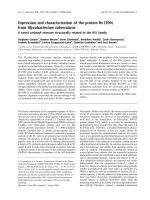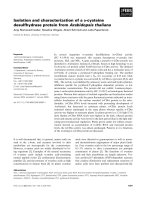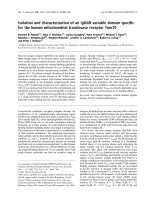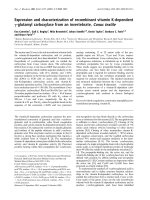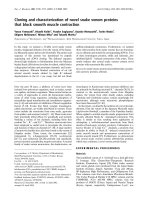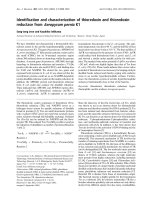Báo cáo y học: "Isolation and characterization of microparticles in sputum from cystic fibrosis patients" pot
Bạn đang xem bản rút gọn của tài liệu. Xem và tải ngay bản đầy đủ của tài liệu tại đây (816.15 KB, 8 trang )
Porro et al. Respiratory Research 2010, 11:94
/>Open Access
RESEARCH
© 2010 Porro et al; licensee BioMed Central Ltd. This is an Open Access article distributed under the terms of the Creative Commons
Attribution License ( which permits unrestricted use, distribution, and reproduction in
any medium, provided the original work is properly cited.
Research
Isolation and characterization of microparticles in
sputum from cystic fibrosis patients
Chiara Porro*
1
, Silvia Lepore
1
, Teresa Trotta
1
, Stefano Castellani
1
, Luigi Ratclif
2
, Anna Battaglino
2
, Sante Di Gioia
1
,
Maria C Martínez
3
, Massimo Conese
†1
and Angela B Maffione
†1
Abstract
Background: Microparticles (MPs) are membrane vesicles released during cell activation and apoptosis. MPs have
different biological effects depending on the cell from they originate. Cystic fibrosis (CF) lung disease is characterized
by massive neutrophil granulocyte influx in the airways, their activation and eventually apoptosis. We investigated on
the presence and phenotype of MPs in the sputum, a rich non-invasive source of inflammation biomarkers, of acute
and stable CF adult patients.
Methods: Spontaneous sputum, obtained from 21 CF patients (10 acute and 11 stable) and 7 patients with primary
ciliary dyskinesia (PCD), was liquefied with Sputasol. MPs were counted, visualized by electron microscopy, and
identified in the supernatants of treated sputum by cytofluorimetry and immunolabelling for leukocyte (CD11a),
granulocyte (CD66b), and monocyte-macrophage (CD11b) antigens.
Results: Electron microscopy revealed that sputum MPs were in the 100-500 nm range and did not contain bacteria,
confirming microbiological tests. CF sputa contained higher number of MPs in comparison with PCD sputa. Levels of
CD11a
+
-and CD66b
+
-, but not CD11b
+
-MPs were significantly higher in CF than in PCD, without differences between
acute and stable patients.
Conclusions: In summary, MPs are detectable in sputa obtained from CF patients and are predominantly of
granulocyte origin. This novel isolation method for MPs from sputum opens a new opportunity for the study of lung
pathology in CF.
Background
In cystic fibrosis (CF), the lung disease is characterized by
high concentrations of neutrophil chemokines, such as
IL-8, and a sustained accumulation of neutrophils in the
airways [1,2], in presence and absence of detectable infec-
tion [3]. In CF airways, neutrophils undergo conventional
activation and functional reprogramming [4-7]. For
example, they show oxidative burst increase, enhanced
production of leukotriens and elastase, increased IL-8
and decreased IL-1 receptor antagonist release (reviewed
in [8,9]). However, the neutrophil response is not capable
to clear bacteria from the CF airways ensuing in exagger-
ated apoptosis of neutrophils [10-13]. Furthermore, neu-
trophils are targeted by Pseudomonas aeruginosa, the
main pulmonary pathogen associated with the disease.
Neutrophils killed by the bacteria release proteases that
disable any neighbouring viable neutrophils [14]. There-
after, bacterial persistence and the products of the dam-
aged neutrophils spur further neutrophil recruitment,
inducing inflammation, tissue damage and then genera-
tion of an environment that allows continued infection.
Sputum is recognized as a very useful sampling method
in CF for both research and clinical use aiding both the
diagnosis and monitoring of lung disease inflammatory
status. A great advantage of the technique is that it
enables sampling of the airways in a non-invasive man-
ner, in contrast with other methods such as bronchial
biopsy, bronchial brushing and broncho-alveolar lavage,
all of which require bronchoscopy, discomfort and risk
that it entails [15]. Furthermore, sputum may contain
protein/peptide components that could act as biomarkers
of disease or its severity [16].
* Correspondence:
1
Department of Biomedical Sciences, University of Foggia, Via L.Pinto 1,
Foggia, 71100, Italy
†
Contributed equally
Full list of author information is available at the end of the article
Porro et al. Respiratory Research 2010, 11:94
/>Page 2 of 8
Microparticles (MPs) are small plasma membrane vesi-
cles that are less than 1 μm released by several cell types
(macrophages, platelets, endothelial cells, granulocytes,
monocytes, lymphocytes) following chemical (cytokines,
thrombin and endotoxin), physical (shear stress and
hypoxia) [17] and apoptotic [18] stimuli. One of the first
described roles for MPs was in the initiation and amplifi-
cation of the coagulation cascade and furthermore they
play a pivotal role in thrombosis, in the propagation of
inflammation, modulation of vascular tone, angiogenesis,
stem cell engraftment, and tumour metastasis. These
MPs' effects depend on molecules harboured at their sur-
face or within their cytoplasm due to their origin cell [18].
MPs are normally present in blood from healthy individu-
als but they increase in patients under pathological states
associated with inflammation, such as sepsis [19], preec-
lampsia [20], metabolic syndrome [21], pulmonary arte-
rial hypertension [22], and malaria [23], strengthening
the notion that MPs may play a role in these diseases. The
phenotype of circulating MPs is also different in different
pathological states, and detection of its cellular origin
may serve as a predictor or marker of the diseases [24].
Mutschler and colleagues, for the first time ever,
showed the presence of MPs, derived from platelet, in
pulmonary air-liquid interfaces in sedated pigs [25].
Recent investigation conducted in broncho-alveolar liq-
uid fluid (BALF) has provided the characterization of
intra-alveolar procoagulant MPs in patients with acute
respiratory distress syndrome (ARDS) and hydrostatic
pulmonary oedema. Intra-alveolar MPs from ARDS
patients contain high levels of tissue factor, show an
highly procoagulant activity, and are likely contribute to
intra-alveolar fibrin formation, a critical pathogenic fea-
ture of acute lung injury [26]. To the best of our knowl-
edge, no studies have been conducted to elucidate about
the presence and role of MPs in other lung diseases. Since
cellular activation and apoptosis, the main sources of
MPs, are features of neutrophils in the CF airways, we
have undertaken a study for the identification and charac-
terization of MPs in the sputa of CF patients.
Patients and Methods
Study patients
The study was approved by, and performed in accordance
with, the ethical standards of our institutional review
boards on human experimentation. Written informed
consent was obtained from each subject.
We enrolled 10 CF patients who consecutively had
been admitted at the CF Center of the Hospital of Ceri-
gnola "G. Tatarella" for parenteral (i.v.) antibiotic therapy
during acute respiratory exacerbation, and 11 stable CF
patients. Exacerbation was defined as a deterioration in
symptoms perceived by the patient and included an
increase in cough, sputum production, dyspnoea, decline
in forced expiratory volume in 1 sec (FEV
1
) compared
with previous best, weight loss and fever [27]. Each
patient was given a clinical score obtained from the sum
of the individual parameters (0 = no symptom; 1 = mod-
erate; 2 = severe). Serum C-reactive protein (CRP) was
assessed as a marker of active inflammation [28]. CF
patients were compared with 7 primary ciliary dyskinesia
(PCD) patients.
Bacterial species in sputum specimens were identified
accordingly to the North-American guidelines [29]. Spu-
tum samples were directly spread-out in selective media,
such as MacConkey agar for Pseudomonas aeruginosa
and Alcaligenes xilosoxidans, manitol salt agar for Staph-
ylococcus aureus, and BCSA for Burkholderia cepacia
complex, and incubated at + 36 ± 1°C for a period of 18-
72 h. Colonies were quantified and identified by classical
(manual) phenotypical tests.
MP isolation
Spontaneous sputum was collected in sterile cup and
immediately processed. The sputum was washed with
NaCl 150 mM, mixed with an equal volume (1:1) of
Sputasol
®
(SR 0233A, Oxoid Ltd, Hampshire, UK), and
then incubated in a water bath at + 37°C for 15 min until
visible homogeneous.
Processed sputum was centrifuged at 37 × g for 3 min
the supernatant was centrifuged at 253 × g for 10 min and
then recentrifuged at 253 × g for 20 min to remove the
cells and large debris, respectively. Two hundred μl of
each MP-containing supernatant were frozen and stored
at-80°C until characterization by flow cytometry and
microbiological tests.
Remaining MP-containing supernatant was centrifuged
at 14,000 × g for 45 min to pellet MPs. MP pellet was sub-
jected at two series of centrifugations at 14,000 × g for 45
min. Finally, MP pellet was replaced in 500 μl of 0.9%
saline salt solution and stored at + 4°C until total count-
ing.
Characterization of MPs
MPs population was characterized in sputum superna-
tant, according to the expression of membrane-specific
antigens. Anti-human CD11a labelling was used to
numerate leukocyte MPs, while numeration of granulo-
cyte MPs and monocyte/macrophage MPs was per-
formed using anti-human CD66b and anti-human
CD11b, respectively. Human IgM was used as isotype-
matched negative control for CD66b staining, while IgG
was used as isotype-matched negative control for CD11a
and CD11b.
For these studies, 10 μl of supernatant MPs were incu-
bated with 10 μl of specific antibody (1 μg/ml; FITC-con-
jugated; BioLegend, San Diego, CA). After 15 min of
incubation at + 4°C, samples were diluted in 500 μl of
Porro et al. Respiratory Research 2010, 11:94
/>Page 3 of 8
0.9% saline salt solution. Then, 10 μl of Flowcount beads
were added to each sample and analyzed in a flow cytom-
eter (Beckman Coulter coulter epics XL-MCL). Sample
analysis was stopped after the count of 10,000 events.
Bacteriological analysis
To rule out whether sputum supernatant staining was due
to bacterial cells, supernatants, used for phenotypic char-
acterization, were plated onto agar plates and kept at +
37°C for 16 hours.
As a further control, we evaluated two bacterial strains
for cross-reaction with antibodies. Pseudomonas aerugi-
nosa PAO1 strain [30] and Staphylococcus aureus ATTC
strain 29213 were thawed and bacteria were recovered on
agar-blood plates. One colony of P. aeruginosa and S.
aureus were allowed to grow in 1 ml of Trypticase Soy
Broth (TSB) (Difco, Becton Dickinson, Sparks, MD) or
BBL™ brain heart infusion (BD Diagnostic Systems,
Sparks, MD) respectively, for 1 hour at + 37°C. Bacteria
were then incubated with 400 μg/ml gentamicin for 2
hours at + 37°C, and subsequently with anti-granulocyte
antibodies under the same conditions of MPs, then finally
analyzed by flow cytometry with the same settings used
for MPs.
Transmission electron microscopy
MPs contained in the supernatant of a processed CF spu-
tum were subjected to a single centrifugation at 14,000 ×
g for 45 min. MP pellet was fixed in 4% glutaraldehyde in
0.1 M cacodylate buffer (pH 7.4) for 24 hours. The sample
was then dehydrated in solutions of ethanol of increasing
strength from 50%, 70%, 95% and 100% for 10 minutes in
each solution. The sample was finally dehydrated in pro-
pylene oxide for 15 minutes. Finally, the sample was
embedded in epoxy resin (Epon 12). After overnight
polymerization, ultrathin sections (70 nm) were cut and
examined in a JEOL (Tokyo, Japan) transmission electron
microscope.
Statistical analysis
Data are shown as mean ± SEM (Table 1) or medians
(quantification and phenotype of MPs present in CF and
PCD sputum). Statistical significance of differences
between acute and stable groups of CF patients was eval-
uated by a two-tailed unpaired Student's t-test. To com-
pare the number of MPs and the amount of different
antigens the non-parametrical Mann-Whitney test was
used. All data were analyzed using Prism 4 (GraphPad
Software, Inc., La Jolla, CA). p values of less than 0.05
were considered significant.
Results
Study patients
Characteristics of patient are summarized in Table 1. CF
patients had more expiratory airflow obstruction, as mea-
sured by the FEV
1
% predicted, although not significantly
different from PCD patients, and were more likely to be
colonized with Pseudomonas aeruginosa and Staphylo-
coccus aureus. In some CF patients, more than one bacte-
rial strain colonized the same patient. The acute and
stable groups of CF patients were well differentiated on
the basis of decrease in FEV
1
as compared with the best
one in the last year (ΔFEV
1
), serum CRP, and clinical
score (Table 1).
Detection of MPs in CF sputa
Sputa liquefied with Sputasol, a dithiothreitol formula-
tion, were centrifuged at low speed to remove large
debris, and studied by flow cytometry analysis. MPs were
readily identified in dot plots (Figure 1A) and were posi-
tive for CD66b antigen (Figure 1D). To discriminate
whether bacteria or bacterial bodies could give such
image, supernatants were plated onto agar plates and no
bacterial growth was observed in sputa obtained from CF
patients. However, to evaluate if bacteria could be stained
by anti-granulocyte antibodies, Pseudomonas aeruginosa
PAO1 were grown for 1 hour and then killed by gentami-
cin treatment. Although detectable in the same region of
MPs (Figure 1B,), killed bacteria, analyzed by flow cytom-
etry after antibody binding did not show any positivity for
the antibody directed against CD66b (Figure 1E).
Also, Staphylococcus aureus ATTC strain 29213 was
incubated with anti-granulocyte CD66b antibody. S.
aureus was partially detectable in the same region of MPs
(Figure 1C) but like P. aeruginosa did not show any posi-
tivity for the antibody directed against CD66b (Figure
1F). Therefore, we conclude that the staining of sputum
supernatant was given only by MPs.
Electron microscopy of sputum MPs
Figure 2 shows electron microscope picture of sputum-
MPs from CF patients. Multiple spherical particles rang-
ing in diameter from 100 to 500 nm were detected. Of
note, no bacterial bodies were found associated with
MPs.
Levels of MPs in CF and PCD sputa
We evaluated the level of MPs in the sputum of 21 CF
patients compared with the sputum of 7 PCD patients.
Although heterogeneous, comprising both stable and
acute patients, the CF group showed a significantly
higher number of MPs than the PCD group (Figure 3).
MP phenotype
MP phenotype was analyzed by evaluating the presence
of antigens representing different cell types: CD11a for
leukocytes, CD66b for granulocytes, CD11b for mono-
cyte/macrophages. In CF patients, amount of MPs
expressing CD66b (median value of 53.8%) was higher
Porro et al. Respiratory Research 2010, 11:94
/>Page 4 of 8
than those expressing CD11a (median value of 16.1%)
and CD11b (median value of 0%). Comparison of all CF
patients versus PCD patients showed that amounts of
MPs expressing CD66b and CD11a were significantly
higher in CF than in PCD (CD66b: p = 0.0068; CD11a: p
= 0.0226) (data not shown). No differences in the three
populations of MPs were found between patients in acute
and stable phase of CF. However, both acute and stable
patients showed significantly higher levels of MPs
expressing CD66b and CD11a in comparison to PCD
patients (for CD66b: stable CF vs. PCD: p = 0.0373; acute
CF vs. PCD: p = 0.0046. For CD11a: stable CF vs. PCD: p
= 0.0464; acute CF vs. PCD: p = 0.0431; Figure 4).
Discussion
Simple and non-invasive biomarkers of lung inflamma-
tion in CF are needed to monitor disease progression,
Table 1: Baseline characteristics of patients.
Stable CF Acute CF p PCD
N 11 10 7
Age (years) 23.4 ± 4.3 24.5 ± 3.7 22.7 ± 3.5
Sex ratio (male:female) 7:4 2:8 3:4
F508del homozygous 5 2 /
F508del heterozygous 4 7 /
Other mutations 1 1 /
FEV
1
(%) 57.8 ± 7.0 49.6 ± 6.4 0.53 75.2 ± 8.4
ΔFEV
1
9.08 ± 2.5 0.07 ± 0.04 0.001 /
CRP (mg/dl) 0.53 ± 0.16 8.36 ± 2.87 0.01 /
Clinical score 7.3 ± 0.37 2.45 ± 0.31 0.001 /
Source of infection:
Pseudomonas aeruginosa 11 6 3
Staphylococcus aureus 33 0
Burkholderia cepacia complex 02 0
Alcaligenes xilosoxidans 01 0
FEV
1
, forced expiratory volume in 1 second as % predicted. In 1 stable CF patient analysis of CFTR mutations is missing. Statistically significant
differences between stable and acute CF patients are shown.
Figure 1 Identification of MPs by flow cytometry. Representative
dot plots and histograms of MPs from sputum from CF patients and P.
aeruginosa and S. aureus. MPs (A), P. aeruginosa PAO1 (B), S. aureus (C)
and calibrator beads (10-μm; Beckman Coulter) are represented on a
forward-scatter/side-scatter dot-plot histogram. MPs, defined as
events with size of 0.1 to 1 μm in diameter, are gated in (a) window
when compared with calibrator beads (CAL), gated in (b). Histograms
showing the CD66b-FITC labelling of MPs from CF sputum (D), and the
lack of staining obtained with control IgM, with P. aeruginosa PAO1 (E)
or S. aureus (F).
E
FITC fluorescence (AU)
Event count
D
FITC fluorescence (AU)
Event count
78.5%
CD66b
IgM
SS Log
FS Log
B
FS Log
SS Log
CD66b
0.2%
A C
FS Log
SS Log
F
FITC fluorescence (AU)
Event count
0.0%
CD66b
MPs
P. a .
S.a.
CAL
CAL
CAL
Figure 2 Transmission electron microscopy of MPs from the spu-
tum of a CF patient. Multiple spherical particles, ranging from 100 to
500 nm, are visualized.
100nm
Porro et al. Respiratory Research 2010, 11:94
/>Page 5 of 8
identify exacerbations, and evaluate the efficacy of novel
therapies [31]. Sputum is a rich, non-invasive source of
biomarkers of inflammation and infection, and has been
used extensively to assess inflammation in the CF airways
(reviewed in [15]). There is compelling evidence from
small single-centre studies supporting an association
between sputum biomarkers and disease status in CF.
Recently, a multicenter cross-sectional study has found
significant negative correlations between FEV
1
% pre-
dicted and spontaneously expectorated sputum inflam-
matory markers including free elastase, IL-8, neutrophil
counts, and percent neutrophils [32].
In this study we provide evidence, for the first time, of
the presence of MPs in sputa obtained from CF patients.
The membrane composition of MPs reflects the plasma
membrane of the original cell at the precise moment of
MPs production and thus allows the characterization of
the cellular source [33] using antibodies directed against
these specific epitopes. Our data strongly support the
notion that MPs are derived from granulocytes, while the
presence of MPs derived from monocyte-macrophages is
negligible. Although there are several potential sources of
sputum MPs, including erythrocytes, platelets, and epi-
thelial cells, our data suggest that granulocytes are the
predominant source of MPs in CF. Our findings are con-
sistent with massive influx of neutrophils into CF airways
and their accumulation on the surface of the airway epi-
thelium [34]. In this environment, neutrophils are acti-
vated by bacterial products, pro-inflammatory cytokines,
and chemokines. Neutrophils undergo apoptosis, as nor-
mally happens in acute inflammation, but also post-apop-
totic necrosis, releasing toxic enzymes and oxygen
radicals. MPs in CF sputa likely reflect both activation
and apoptosis of neutrophils. In order to evaluate the
effect of bacterial infection on MPs production, it would
be interesting to compare subgroups based on the pres-
ence or absence of infection with Pseudomonas aerugi-
nosa or other bacterial strains, therefore further studies
with larger number of patients are needed. PCD patients
were selected as controls because healthy donors do not
produce spontaneous sputum; moreover, PCD patients
have similar respiratory infections to CF patients. In
PCD, neutrophilic lung inflammation, incidence of lung
infection, offending organisms, development of bron-
chiectasis and longitudinal declines in lung function are
similar to CF but appear to be delayed, and serious lung
disease tends to develop later in life [35-37]. This could be
the reason for a significantly less presence of granulocyte-
derived MPs in PCD when compared with CF patients.
The mechanisms of MP formation are complex and not
completely elucidated. Following cell activation or apop-
Figure 4 Phenotype of MPs present in sputa of acute and stable
CF and PCD patients. In acute and stable CF patients, the number of
MPs staining positive for FITC-conjugated antibodies directed against
CD11a are significantly higher than in PCD patients (A). Stable CF vs.
PCD: *p = 0.0464. Acute CF vs. PCD: *p = 0.0431. MPs positive to CD66b,
both in acute and in stable phase of CF, are significantly elevated in re-
spect to PCD (B). Stable CF vs. PCD: *p = 0.0373. Acute CF vs. PCD: **p
= 0.0046. Positivity of MPs to CD11b is not significantly different in the
three groups of patients (C).
stable acute PCD
0
25
50
75
stable acute PCD
0
25
50
75
% of CD66b
+
MPs
% of CD11b
+
MPs
% of CD11a
+
MPs
*
*
**
B)
A)
C)
stable acute PCD
0
5
10
15
Figure 3 Quantification of MPs in CF and PCD sputum. Total MPs
present in sputum of CF and PCD patients. CF patients (n = 21) show a
significant higher number of MPs respect to PCD patients (n = 7). *p =
0.00297.
Number of MPs (x 10
8
)/µl of sputum
*
PCD CF
2.5
5
7.5
10
0
Porro et al. Respiratory Research 2010, 11:94
/>Page 6 of 8
tosis, MPs formation is dependent on a sustained rise in
the cytosolic Ca
2+
concentration with the consequent
activation of different cytosolic enzyme relevant to MPs
formation. Calpain is one of the most important enzyme
and has several actions in MPs generation including
cleaving of cytoskeletal filaments, facilitating microparti-
cle shedding, and activating apoptosis through procas-
pase-3 [38]. These changes result in cytoskeletal
reorganization, loss of the asymmetric distribution of
aminophospholipid, membrane blebbing and MP forma-
tion [39].
Some release of shedding vesicles takes place from rest-
ing cells, however the rate of the process increases dra-
matically upon stimulation [40]. Ca
2+
is not the only
second messenger involved. In various cell types, in fact,
phorbol ester activation of protein kinase C (PKC) is also
effective. In PC12 cells, shedding vesicles are released
upon application of phorbol esters and not of Ca
2+
iono-
phores. The purinergic receptors of ATP, a ligand
released by many cell types, have an important role. In
dendritic cells, macrophages and microglia, activation of
the purinergic receptor channel, P2X7, was found to
induce intense release of MPs. In other cell types (such as
PC12 and platelets), activation of the P2Y receptors cou-
pled with the Gq protein was found to be effective.
Electron or confocal laser scan microscopy can be used
for better characterization of morphological features or
visualization of MPs. Indeed, here we show that sputum
MPs display a range between 100 and 500 nm, larger than
that previously shown for MPs obtained from edema
fluid of a patient with ARDS [26]. However the most
widely used method for studying MPs is flow cytometry
due to its simplicity and the wealth of information that
can be gleaned from the population under study [17]. The
major advantage of flow cytometry is staining of MPs to
determine the origin/cellular source of MPs. In addition,
flow cytometry can also be used to enumerate blood MPs
by adding a known number of fuorescent or non fuores-
cent latex particles to the sample prior to performing
analysis [41].
Microvesicles also originate from the endosomal mem-
brane compartment after fusion of secretory granules
with the plasma membrane, where they exist as intralu-
minal membrane-bound vesicles called exosomes. These
exosomes are released from cells during exocytosis of
secretory granules together with the proteins present
inside these granules. MPs are released from the surface
of membrane during membrane blebbing in a calcium
flux and calpain-dependent manner and are relatively
large (100 nm-1 μm). In contrast smaller exosomes that
are more homogeneous in size (30-100 nm) are released
from the endosomal compartment [42]. In the only paper
reporting a direct comparison, the shedding vesicles of
platelets 'could be detected by flow cytometry but not the
exosomes, probably because of the smaller size of the lat-
ter' [43].
MPs contain numerous proteins and lipids similar to
those present in the cell membranes from which they
originate. Furthermore, as MPs' membranes engulf some
cytoplasm during membrane blebbing, they may also
contain proteins derived from it, mRNA, and, as recently
demonstrated, microRNA (miRNA) [44]. It is now
emerging that miRNAs may play a key role in host
defence and inflammation [45,46]. Moreover, MPs may
"hijack" infectious particles (e.g. human immuno defi-
ciency virus (HIV) or prions) from the cytoplasm or pos-
sibly even whole intact organelles such as the
mitochondria [42].
A question remains unresolved: whether MPs present
in CF sputa have functional consequences on the
pathophysiology of CF lung disease. Recent data bring the
evidence that MPs can transfer message from different
type of cells. The mechanisms by which MPs may influ-
ence biology of target cell could be different; MPs may (i)
stimulate other cells by surface-expressed ligands acting
as a signalling complex, (ii) transfer surface receptors
from one cell to another, (iii) deliver proteins, mRNA,
miRNAs, and bioactive lipids into target cells or (iv) serve
as a vehicle for the transfer of infectious particles (e.g.
HIV, prion) [42].
Conclusions
Sputum through its inflammatory cell, bacterial, volatiles,
mucin and protein content represent an important tool
for the diagnosis and monitoring of CF and other respira-
tory diseases, beside for the study of disease pathogenesis
and its treatment. Measurement of these components is
largely sophisticated and quantifiable, and the search for
novel biomarkers of CF airways disease in this biofluid is
under way [16,47]. The finding of MPs in sputum raises
some intriguing questions on the pathophysiological role
of MPs in pulmonary epithelium. Our data strongly sup-
port the notion that MPs are derived from granulocytes
of CF patients, and this correlates with massive influx of
neutrophils into CF airways and their accumulation on
the surface of the airway epithelium [34]. In this environ-
ment, neutrophil-derived MPs could contribute to self-
perpetuating inflammatory cycle, and may account for
the exaggerated proinflammatory response of cells in CF
patients.
Independently of the potential role played by MPs in
CF, taking in consideration the fact that CD66b
+
MPs are
present in higher level in CF than in PCD sputum, they
might be considered as biological markers of this pathol-
ogy. Taken together, these data open a new opportunity
for the study of lung pathology.
Porro et al. Respiratory Research 2010, 11:94
/>Page 7 of 8
Competing interests
The authors declare that they have no competing interests.
Authors' contributions
CP performed all experimental steps and wrote the manuscript; SL, TT, SC and
SDG provided experimental assistance; LR and AB enrolled patients; ABM, MC
and MCM conceived the study, supervised this project and participated in its
coordination and helped to draft the manuscript. All authors read and
approved the final manuscript
Acknowledgements
This work was funded in part by "Fondazione Banca del Monte-Domenico
Siniscalco Ceci". We thank Raffaele Antonetti, Anna Di Taranto and Maria Iole
Natalicchio (Clinical Microbiology Unit, University of Foggia) for giving us sup-
port with the microbiological analyses. We also thank Robert Filmon and Sonia
Georgeault (SCIAM, Université Angers) for assistance in transmission electron
microscopy.
Author Details
1
Department of Biomedical Sciences, University of Foggia, Via L.Pinto 1, Foggia,
71100, Italy,
2
Centro Regionale di Supporto FC, Ospedale "G. Tatarella", Via
Trinitapoli, Cerignola, 71042, Italy and
3
INSERM U694, Université d'Angers, Rue
Haute de Reculée, Angers, 49045, France
References
1. Bonfield TL, Panuska JR, Konstan MW, Hilliard KA, Hilliard JB, Ghnaim H,
Berger M: Inflammatory cytokines in cystic fibrosis lungs. Am J Respir
Crit Care Med 1995, 152:2111-2118.
2. Muhlebach MS, Reed W, Noah TL: Quantitative cytokine gene
expression in CF airway. Pediatr Pulmonol 2004, 37(5):393-399.
3. Khan TZ, Wagener JS, Bost T, Martinez J, Accurso FJ, Riches DWH: Early
pulmonary inflammation in infants with cystic fibrosis. Am J Respir Crit
Care Med 1995, 151:1075-1082.
4. Corvol H, Fitting C, Chadelat K, Jacquot J, Tabary O, Boule M, Cavaillon JM,
Clement A: Distinct cytokine production by lung and blood neutrophils
from children with cystic fibrosis. Am J Physiol Lung Cell Mol Physiol 2003,
284(6):L997-1003.
5. Makam M, Diaz D, Laval J, Gernez Y, Conrad CK, Dunn CE, Davies ZA, Moss
RB, Herzenberg LA, Herzenberg LA, et al.: Activation of critical, host-
induced, metabolic and stress pathways marks neutrophil entry into
cystic fibrosis lungs. Proc Natl Acad Sci USA 2009, 106(14):5779-5783.
6. Tirouvanziam R, Gernez Y, Conrad CK, Moss RB, Schrijver I, Dunn CE, Davies
ZA, Herzenberg LA, Herzenberg LA: Profound functional and signaling
changes in viable inflammatory neutrophils homing to cystic fibrosis
airways. Proc Natl Acad Sci USA 2008, 105(11):4335-4339.
7. Petit-Bertron AF, Tabary O, Corvol H, Jacquot J, Clement A, Cavaillon JM,
Adib-Conquy M: Circulating and airway neutrophils in cystic fibrosis
display different TLR expression and responsiveness to interleukin-10.
Cytokine 2008, 41(1):54-60.
8. Conese M, Copreni E, Di Gioia S, De Rinaldis P, Fumarulo R: Neutrophil
recruitment and airway epithelial cell involvement in chronic cystic
fibrosis lung disease. J Cystic Fibrosis 2003, 2:129-135.
9. Downey DG, Bell SC, Elborn JS: Neutrophils in cystic fibrosis. Thorax
2009, 64(1):81-88.
10. Watt AP, Courtney J, Moore J, Ennis M, Elborn JS: Neutrophil cell death,
activation and bacterial infection in cystic fibrosis. Thorax 2005,
60(8):659-664.
11. Vandivier RW, Fadok VA, Hoffmann PR, Bratton DL, Penvari C, Brown KK,
Brain JD, Accurso FJ, Henson PM: Elastase-mediated phosphatidylserine
receptor cleavage impairs apoptotic cell clearance in cystic fibrosis and
bronchiectasis. J Clin Invest 2002, 109(5):661-670.
12. Vandivier RW, Richens TR, Horstmann SA, deCathelineau AM, Ghosh M,
Reynolds SD, Xiao YQ, Riches DW, Plumb J, Vachon E, et al.: Dysfunctional
cystic fibrosis transmembrane conductance regulator inhibits
phagocytosis of apoptotic cells with proinflammatory consequences.
Am J Physiol Lung Cell Mol Physiol 2009, 297(4):L677-686.
13. Tabary O, Corvol H, Boncoeur E, Chadelat K, Fitting C, Cavaillon JM,
Clement A, Jacquot J: Adherence of airway neutrophils and
inflammatory response are increased in CF airway epithelial cell-
neutrophil interactions. Am J Physiol Lung Cell Mol Physiol 2006,
290(3):L588-596.
14. Hartl D, Latzin P, Hordijk P, Marcos V, Rudolph C, Woischnik M, Krauss-
Etschmann S, Koller B, Reinhardt D, Roscher AA, et al.: Cleavage of CXCR1
on neutrophils disables bacterial killing in cystic fibrosis lung disease.
Nat Med 2007, 13(12):1423-1430.
15. Sagel SD, Chmiel JF, Konstan MW: Sputum biomarkers of inflammation
in cystic fibrosis lung disease. Proc Am Thorac Soc 2007, 4(4):406-417.
16. Nicholas B, Djukanovic R: Induced sputum: a window to lung
pathology. Biochem Soc Trans 2009, 37(Pt 4):868-872.
17. Nomura S, Ozaki Y, Ikeda Y: Function and role of microparticles in
various clinical settings. Thromb Res 2008, 123(1):8-23.
18. Benameur T, Andriantsitohaina R, Martinez MC: Therapeutic potential of
plasma membrane-derived microparticles. Pharmacol Rep 2009,
61(1):49-57.
19. Mostefai HA, Meziani F, Mastronardi ML, Agouni A, Heymes C, Sargentini
C, Asfar P, Martinez MC, Andriantsitohaina R: Circulating microparticles
from patients with septic shock exert protective role in vascular
function. Am J Respir Crit Care Med 2008, 178(11):1148-1155.
20. Meziani F, Tesse A, David E, Martinez MC, Wangesteen R, Schneider F,
Andriantsitohaina R: Shed membrane particles from preeclamptic
women generate vascular wall inflammation and blunt vascular
contractility. Am J Pathol 2006, 169(4):1473-1483.
21. Agouni A, Lagrue-Lak-Hal AH, Ducluzeau PH, Mostefai HA, Draunet-
Busson C, Leftheriotis G, Heymes C, Martinez MC, Andriantsitohaina R:
Endothelial dysfunction caused by circulating microparticles from
patients with metabolic syndrome. Am J Pathol 2008, 173(4):1210-1219.
22. Tual-Chalot S, Guibert C, Muller B, Savineau JP, Andriantsitohaina R,
Martinez MC: Circulating Microparticles from Pulmonary Hypertensive
Rats Induce Endothelial Dysfunction. Am J Respir Crit Care Med 2010.
23. Couper KN, Barnes T, Hafalla JC, Combes V, Ryffel B, Secher T, Grau GE,
Riley EM, de Souza JB: Parasite-derived plasma microparticles
contribute significantly to malaria infection-induced inflammation
through potent macrophage stimulation. PLoS Pathog 2010,
6(1):e1000744.
24. Martinez MC, Tesse A, Zobairi F, Andriantsitohaina R: Shed membrane
microparticles from circulating and vascular cells in regulating vascular
function. Am J Physiol Heart Circ Physiol 2005, 288(3):H1004-1009.
25. Mutschler DK, Larsson AO, Basu S, Nordgren A, Eriksson MB: Effects of
mechanical ventilation on platelet microparticles in bronchoalveolar
lavage fluid. Thromb Res 2002, 108(4):215-220.
26. Bastarache JA, Fremont RD, Kropski JA, Bossert FR, Ware LB: Procoagulant
alveolar microparticles in the lungs of patients with acute respiratory
distress syndrome. Am J Physiol Lung Cell Mol Physiol 2009,
297(6):L1035-1041.
27. Wolter JM, Rodwell RL, Bowler SD, McCormack JG: Cytokines and
inflammatory mediators do not indicate acute infection in cystic
fibrosis. Clin Diagn LabImmunol 1999, 6:260-265.
28. Levy H, Kalish LA, Huntington I, Weller N, Gerard C, Silverman EK, Celedon
JC, Pier GB, Weiss ST: Inflammatory markers of lung disease in adult
patients with cystic fibrosis. Pediatr Pulmonol 2007, 42(3):256-262.
29. Saiman L, Siegel J: Infection control recommendations for patients with
cystic fibrosis: Microbiology, important pathogens, and infection
control practices to prevent patient-to-patient transmission. Am J
Infect Control 2003, 31(3 Suppl):S1-62.
30. Stover CK, Pham XQ, Erwin AL, Mizoguchi SD, Warrener P, Hickey MJ,
Brinkman FS, Hufnagle WO, Kowalik DJ, Lagrou M, et al.: Complete
genome sequence of Pseudomonas aeruginosa PAO1, an
opportunistic pathogen. Nature 2000, 406:959-964.
31. Sagel SD: Noninvasive biomarkers of airway inflammation in cystic
fibrosis. Curr Opin Pulm Med 2003, 9(6):516-521.
32. Mayer-Hamblett N, Aitken ML, Accurso FJ, Kronmal RA, Konstan MW,
Burns JL, Sagel SD, Ramsey BW: Association between pulmonary
function and sputum biomarkers in cystic fibrosis. Am J Respir Crit Care
Med 2007, 175(8):822-828.
33. Janowska-Wieczorek A, Majka M, Kijowski J, Baj-Krzyworzeka M, Reca R,
Turner AR, Ratajczak J, Emerson SG, Kowalska MA, Ratajczak MZ: Platelet-
derived microparticles bind to hematopoietic stem/progenitor cells
and enhance their engraftment. Blood 2001, 98(10):3143-3149.
Received: 18 February 2010 Accepted: 9 July 2010
Published: 9 July 2010
This article is available from: 2010 Porro et al; licensee BioMed Central Ltd. This is an Open Access article distributed under the terms of the Creative Commons Attribution License ( ), which permits unrestricted use, distribution, and reproduction in any medium, provided the original work is properly cited.Respiratory Research 2010, 11:94
Porro et al. Respiratory Research 2010, 11:94
/>Page 8 of 8
34. Hubeau C, Lorenzato M, Couetil JP, Hubert D, Dusser D, Puchelle E,
Gaillard D: Quantitative analysis of inflammatory cells infiltrating the
cystic fibrosis airway mucosa. Clin Exp Immunol 2001, 124(1):69-76.
35. Livraghi A, Randell SH: Cystic fibrosis and other respiratory diseases of
impaired mucus clearance. Toxicol Pathol 2007, 35(1):116-129.
36. Zihlif N, Paraskakis E, Tripoli C, Lex C, Bush A: Markers of airway
inflammation in primary ciliary dyskinesia studied using exhaled
breath condensate. Pediatr Pulmonol 2006, 41(6):509-514.
37. Noone PG, Leigh MW, Sannuti A, Minnix SL, Carson JL, Hazucha M,
Zariwala MA, Knowles MR: Primary ciliary dyskinesia: diagnostic and
phenotypic features. Am J Respir Crit Care Med 2004, 169(4):459-467.
38. Cohen Z, Gonzales RF, Davis-Gorman GF, Copeland JG, McDonagh PF:
Thrombin activity and platelet microparticle formation are increased in
type 2 diabetic platelets: a potential correlation with caspase
activation. Thromb Res 2002, 107(5):217-221.
39. Mostefai HA, Andriantsitohaina R, Martinez MC: Plasma membrane
microparticles in angiogenesis: role in ischemic diseases and in cancer.
Physiol Res 2008, 57(3):311-320.
40. Cocucci E, Racchetti G, Meldolesi J: Shedding microvesicles: artefacts no
more. Trends Cell Biol 2009, 19(2):43-51.
41. Shet AS: Characterizing blood microparticles: technical aspects and
challenges. Vasc Health Risk Manag 2008, 4(4):769-774.
42. Ratajczak J, Wysoczynski M, Hayek F, Janowska-Wieczorek A, Ratajczak MZ:
Membrane-derived microvesicles: important and underappreciated
mediators of cell-to-cell communication. Leukemia 2006,
20(9):1487-1495.
43. Heijnen HF, Schiel AE, Fijnheer R, Geuze HJ, Sixma JJ: Activated platelets
release two types of membrane vesicles: microvesicles by surface
shedding and exosomes derived from exocytosis of multivesicular
bodies and alpha-granules. Blood 1999, 94(11):3791-3799.
44. Hunter MP, Ismail N, Zhang X, Aguda BD, Lee EJ, Yu L, Xiao T, Schafer J, Lee
ML, Schmittgen TD, et al.: Detection of microRNA expression in human
peripheral blood microvesicles. PLoS One 2008, 3(11):e3694.
45. O'Connell RM, Rao DS, Chaudhuri AA, Baltimore D: Physiological and
pathological roles for microRNAs in the immune system. Nat Rev
Immunol 2010, 10(2):111-122.
46. Tsitsiou E, Lindsay MA: microRNAs and the immune response. Curr Opin
Pharmacol 2009, 9(4):514-520.
47. Gray RD, MacGregor G, Noble D, Imrie M, Dewar M, Boyd AC, Innes JA,
Porteous DJ, Greening AP: Sputum proteomics in inflammatory and
suppurative respiratory diseases. Am J Respir Crit Care Med 2008,
178(5):444-452.
doi: 10.1186/1465-9921-11-94
Cite this article as: Porro et al., Isolation and characterization of microparti-
cles in sputum from cystic fibrosis patients Respiratory Research 2010, 11:94


